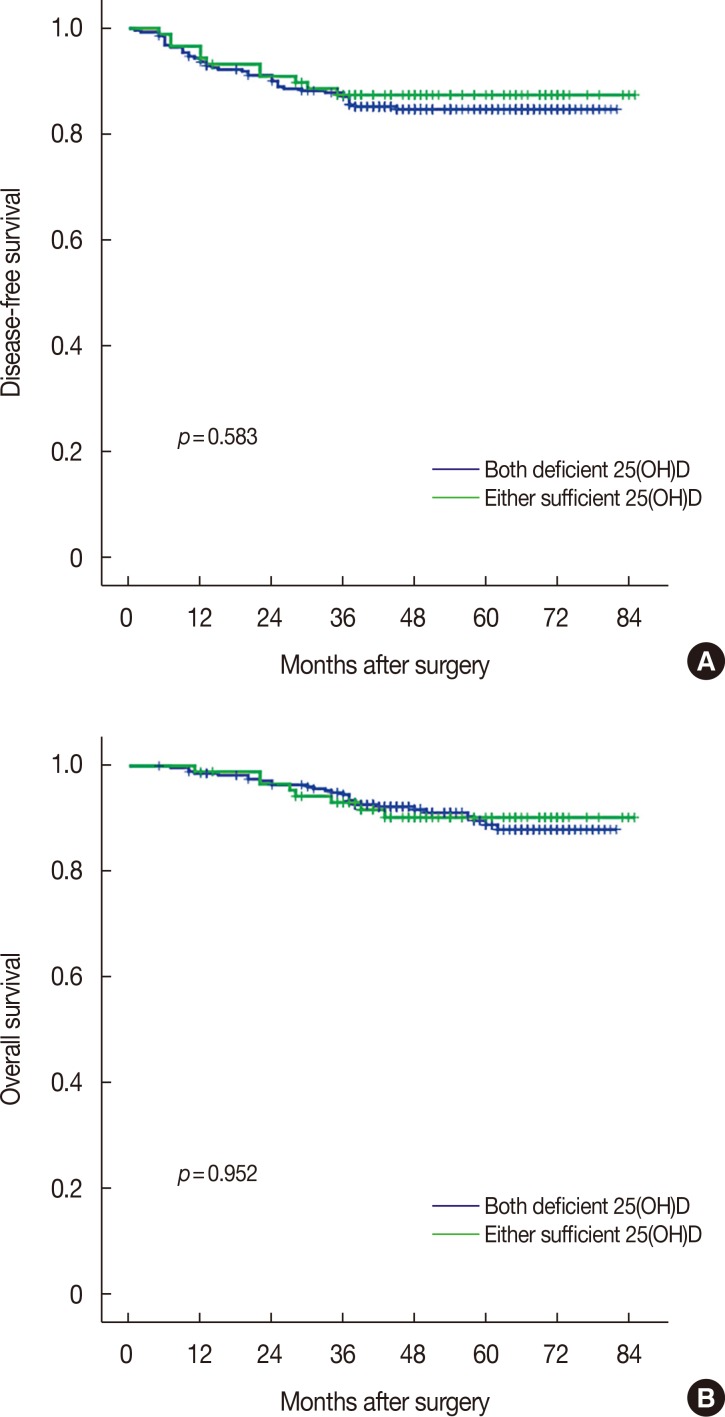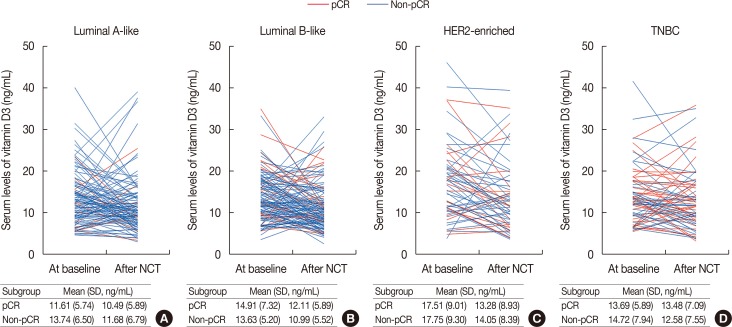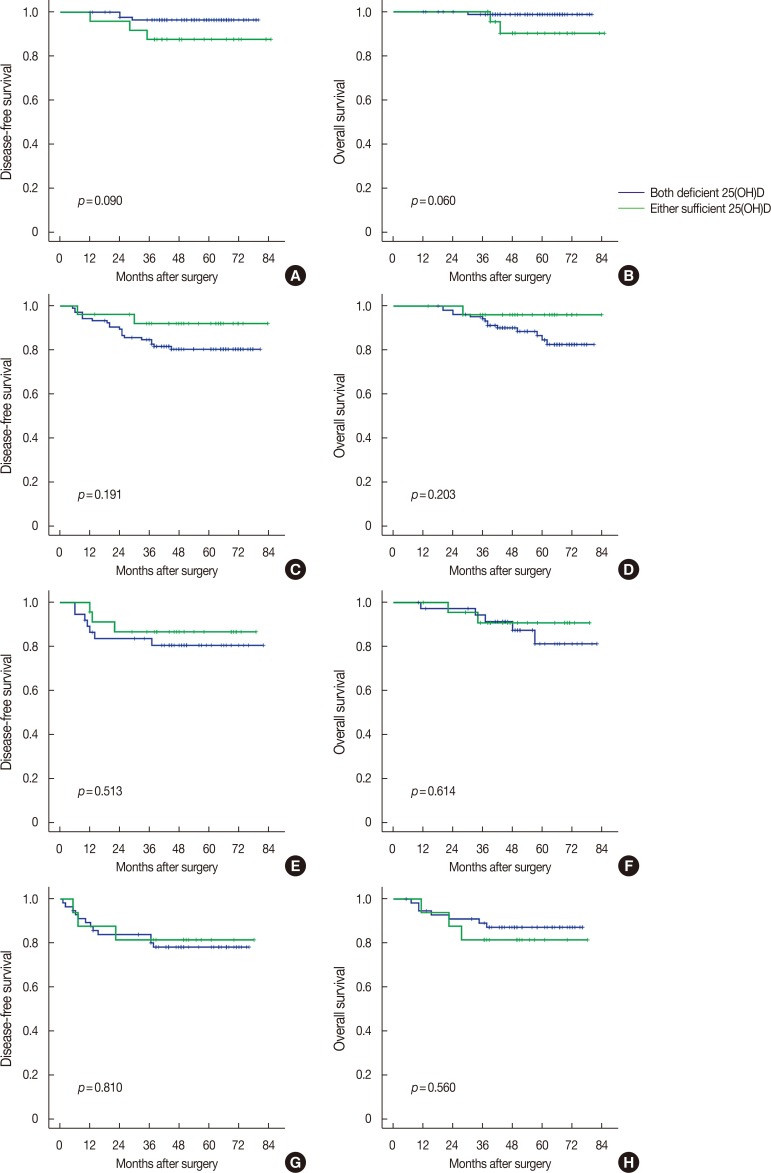J Breast Cancer.
2018 Jun;21(2):134-141. 10.4048/jbc.2018.21.2.134.
Association between Changes in Serum 25-Hydroxyvitamin D Levels and Survival in Patients with Breast Cancer Receiving Neoadjuvant Chemotherapy
- Affiliations
-
- 1Department of Surgery, Yonsei University College of Medicine, Seoul, Korea. psh1025@yuhs.ac
- 2Department of Surgery, Muhimbili National Hospital, Dar es Salaam, Tanzania.
- 3Frontier Research Institute of Convergence Sports Science, Yonsei University, Seoul, Korea.
- KMID: 2413931
- DOI: http://doi.org/10.4048/jbc.2018.21.2.134
Abstract
- PURPOSE
We investigated the changes in serum 25-hydroxyvitamin D (25[OH]D) levels before and after neoadjuvant chemotherapy (NCT) and the associations with pathologic complete response (pCR) and survival in patients with breast cancer.
METHODS
Serum 25(OH)D concentrations were measured pre- and post-NCT in 374 patients between 2010 and 2013. Based on a cutoff of 20 ng/mL, patients were categorized into "either sufficient" or "both deficient" groups. The associations with clinicopathological data, including pCR and survival, were analyzed using multivariable analyses.
RESULTS
Patients with either pre- or post-NCT sufficient 25(OH)D levels accounted for 23.8%, and the overall pCR rate was 25.9%. Most patients showed 25(OH)D deficiency at diagnosis and 65.8% showed decreased serum levels after NCT. Changes in 25(OH)D status were associated with postmenopause status, rural residence, baseline summer examination, and molecular phenotype, but not pCR. No association between survival and 25(OH)D status was found, including in the subgroup analyses based on molecular phenotypes.
CONCLUSION
Most Korean patients with breast cancer showed vitamin D deficiency at diagnosis and a significant decrease in the serum concentration after NCT. No association with oncologic outcomes was found. Therefore, although optimal management for vitamin D deficiency is urgent for skeletal health, further research is warranted to clearly determine the prognostic role of vitamin D in patients with breast cancer who are candidates for NCT.
MeSH Terms
Figure
Reference
-
1. Wang D, Vélez de-la-Paz OI, Zhai JX, Liu DW. Serum 25-hydroxyvitamin D and breast cancer risk: a meta-analysis of prospective studies. Tumour Biol. 2013; 34:3509–3517. PMID: 23807676.
Article2. Rose AA, Elser C, Ennis M, Goodwin PJ. Blood levels of vitamin D and early stage breast cancer prognosis: a systematic review and meta-analysis. Breast Cancer Res Treat. 2013; 141:331–339. PMID: 24104883.
Article3. Yao S, Kwan ML, Ergas IJ, Roh JM, Cheng TD, Hong CC, et al. Association of serum level of vitamin D at diagnosis with breast cancer survival: a case-cohort analysis in the pathways study. JAMA Oncol. 2017; 3:351–357. PMID: 27832250.4. Chlebowski RT, Johnson KC, Kooperberg C, Pettinger M, Wactawski-Wende J, Rohan T, et al. Calcium plus vitamin D supplementation and the risk of breast cancer. J Natl Cancer Inst. 2008; 100:1581–1591. PMID: 19001601.
Article5. Lohmann AE, Chapman JA, Burnell MJ, Levine MN, Tsvetkova E, Pritchard KI, et al. Prognostic associations of 25 hydroxy vitamin D in NCIC CTG MA.21, a phase III adjuvant randomized clinical trial of three chemotherapy regimens in high-risk breast cancer. Breast Cancer Res Treat. 2015; 150:605–611. PMID: 25833209.
Article6. Clark AS, Chen J, Kapoor S, Friedman C, Mies C, Esserman L, et al. Pretreatment vitamin D level and response to neoadjuvant chemotherapy in women with breast cancer on the I-SPY trial (CALGB 150007/150015/ACRIN6657). Cancer Med. 2014; 3:693–701. PMID: 24719175.7. Charehbili A, Hamdy NA, Smit VT, Kessels L, van Bochove A, van Laarhoven HW, et al. Vitamin D (25-0H D3) status and pathological response to neoadjuvant chemotherapy in stage II/III breast cancer: data from the NEOZOTAC trial (BOOG 10-01). Breast. 2016; 25:69–74. PMID: 26614548.
Article8. Taylor CL, Sempos CT, Davis CD, Brannon PM. Vitamin D: moving forward to address emerging science. Nutrients. 2017; 9:E1308. PMID: 29194368.
Article9. van Schoor N, Lips P. Global overview of vitamin D status. Endocrinol Metab Clin North Am. 2017; 46:845–870. PMID: 29080639.
Article10. Jacot W, Pouderoux S, Thezenas S, Chapelle A, Bleuse JP, Romieu G, et al. Increased prevalence of vitamin D insufficiency in patients with breast cancer after neoadjuvant chemotherapy. Breast Cancer Res Treat. 2012; 134:709–717. PMID: 22562178.
Article11. Kim HJ, Koh BS, Yu JH, Lee JW, Son BH, Kim SB, et al. Changes in serum hydroxyvitamin D levels of breast cancer patients during tamoxifen treatment or chemotherapy in premenopausal breast cancer patients. Eur J Cancer. 2014; 50:1403–1411. PMID: 24703104.
Article12. Moukayed M, Grant WB. The roles of UVB and vitamin D in reducing risk of cancer incidence and mortality: a review of the epidemiology, clinical trials, and mechanisms. Rev Endocr Metab Disord. 2017; 18:167–182. PMID: 28213657.
Article13. Ross AC, Manson JE, Abrams SA, Aloia JF, Brannon PM, Clinton SK, et al. The 2011 report on dietary reference intakes for calcium and vitamin D from the Institute of Medicine: what clinicians need to know. J Clin Endocrinol Metab. 2011; 96:53–58. PMID: 21118827.
Article14. Hammond ME, Hayes DF, Dowsett M, Allred DC, Hagerty KL, Badve S, et al. American Society of Clinical Oncology/College of American Pathologists guideline recommendations for immunohistochemical testing of estrogen and progesterone receptors in breast cancer. J Clin Oncol. 2010; 28:2784–2795. PMID: 20404251.
Article15. Wolff AC, Hammond ME, Hicks DG, Dowsett M, McShane LM, Allison KH, et al. Recommendations for human epidermal growth factor receptor 2 testing in breast cancer: American Society of Clinical Oncology/College of American Pathologists clinical practice guideline update. J Clin Oncol. 2013; 31:3997–4013. PMID: 24101045.
Article16. Oh MG, Han MA, Park J, Ryu SY, Choi SW. The prevalence of vitamin D deficiency among cancer survivors in a nationwide survey of the Korean population. PLoS One. 2015; 10:e0129901. PMID: 26047013.
Article17. Crew KD, Shane E, Cremers S, McMahon DJ, Irani D, Hershman DL. High prevalence of vitamin D deficiency despite supplementation in premenopausal women with breast cancer undergoing adjuvant chemotherapy. J Clin Oncol. 2009; 27:2151–2156. PMID: 19349547.
Article18. Miyoshi Y, Ando A, Takamura Y, Taguchi T, Tamaki Y, Noguchi S. Prediction of response to docetaxel by CYP3A4 mRNA expression in breast cancer tissues. Int J Cancer. 2002; 97:129–132. PMID: 11774254.
Article20. Fuleihan Gel-H, Bouillon R, Clarke B, Chakhtoura M, Cooper C, McClung M, et al. Serum 25-hydroxyvitamin D levels: variability, knowledge gaps, and the concept of a desirable range. J Bone Miner Res. 2015; 30:1119–1133. PMID: 25952470.
Article21. Zhang X, Harbeck N, Jeschke U, Doisneau-Sixou S. Influence of vitamin D signaling on hormone receptor status and HER2 expression in breast cancer. J Cancer Res Clin Oncol. 2017; 143:1107–1122. PMID: 28025696.
Article22. Welsh J. Function of the vitamin D endocrine system in mammary gland and breast cancer. Mol Cell Endocrinol. 2017; 453:88–95. PMID: 28579119.
Article23. Picotto G, Liaudat AC, Bohl L, Tolosa de Talamoni N. Molecular aspects of vitamin D anticancer activity. Cancer Invest. 2012; 30:604–614. PMID: 22963190.
Article24. Hu K, Callen DF, Li J, Zheng H. Circulating vitamin D and overall survival in breast cancer patients: a dose-response meta-analysis of cohort studies. Integr Cancer Ther. 2018; 17:217–225. PMID: 28589744.
Article25. de Sousa Almeida-Filho B, De Luca Vespoli H, Pessoa EC, Machado M, Nahas-Neto J, Nahas EA. Vitamin D deficiency is associated with poor breast cancer prognostic features in postmenopausal women. J Steroid Biochem Mol Biol. 2017; 174:284–289. PMID: 29031688.26. Buono G, Giuliano M, De Angelis C, Lauria R, Forestieri V, Pensabene M, et al. Pretreatment serum concentration of vitamin D and breast cancer characteristics: a prospective observational mediterranean study. Clin Breast Cancer. 2017; 17:559–563. PMID: 28601383.
Article27. Kim Y, Je Y. Vitamin D intake, blood 25(OH)D levels, and breast cancer risk or mortality: a meta-analysis. Br J Cancer. 2014; 110:2772–2784. PMID: 24714744.
Article28. Li M, Chen P, Li J, Chu R, Xie D, Wang H. Review: the impacts of circulating 25-hydroxyvitamin D levels on cancer patient outcomes: a systematic review and meta-analysis. J Clin Endocrinol Metab. 2014; 99:2327–2336. PMID: 24780061.
- Full Text Links
- Actions
-
Cited
- CITED
-
- Close
- Share
- Similar articles
-
- Comment to "Vitamin D Receptor Poly(A) Microsatellite Polymorphism and 25-Hydroxyvitamin D Serum Levels: Association with Susceptibility to Breast Cancer"
- The Influence of Anxiety, Uncertainty, and Cancer Coping on the Quality of Life in Breast Cancer Patients Receiving Neoadjuvant Chemotherapy
- The Predictive Value of Pre-therapeutic Serum Gamma-glutamyl transferase in Efficacy and Adverse Reactions to Neoadjuvant Chemotherapy among Breast Cancer Patients
- Vitamin D Receptor Poly(A) Microsatellite Polymorphism and 25-Hydroxyvitamin D Serum Levels: Association with Susceptibility to Breast Cancer
- The Predictive Value of Serum HER2/neu for Response to Anthracycline-Based and Trastuzumab-Based Neoadjuvant Chemotherapy




